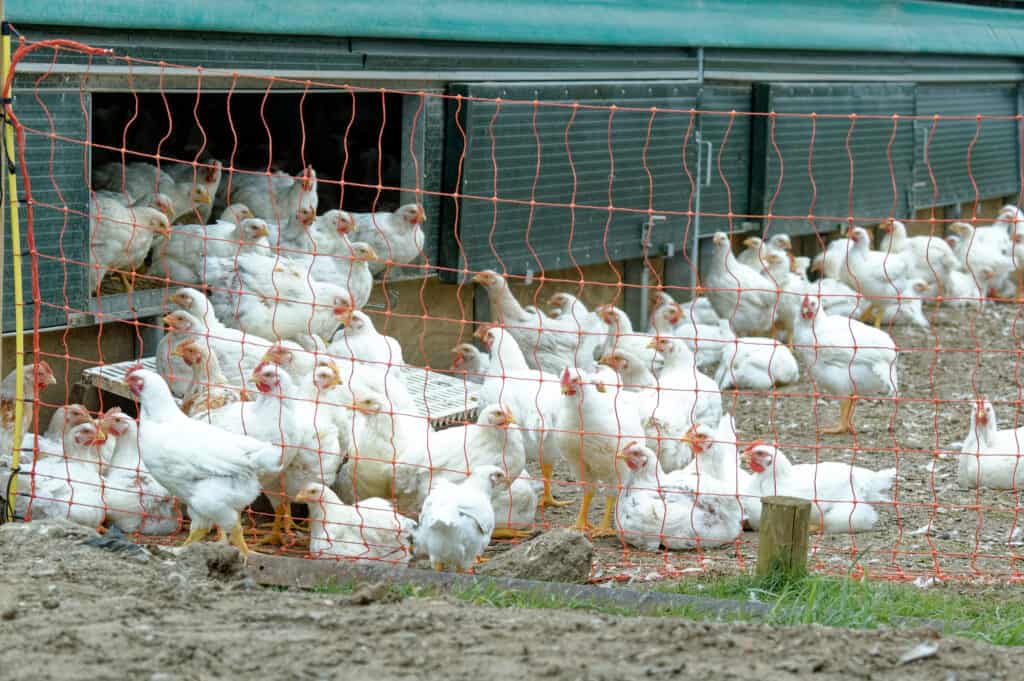Store Bought vs. Organic Farm Fresh Eggs: What’s The Difference? Eggs are one of the more versatile foods in our diets. Whether they are eaten scrambled, fried, boiled, poached or deviled, eggs have eaten around the globe. Eggs provide structure to baked goods and pasta. And while chicken eggs are easily the most common eggs sold in the U.S., duck eggs, goose eggs, quail eggs, and guinea fowl eggs are gaining in popularity. And why not? Eggs are filled with many nutrients, including vitamins A, B, D, E, and K, as well as the minerals phosphorus, selenium, calcium, and zinc.

Eggs are eaten scrambled, fried, boiled, poached and deviled.
©Brent Hofacker/Shutterstock.com
Presently, more individuals than ever are raising chickens in their own backyards to provide fresh eggs for their loved ones. But are fresh eggs really more healthful than the store bought variety?
What are the differences between store bought and organic farm fresh eggs? Read on to find out!
Store Bought vs. Organic Farm Fresh Eggs: Store Bought Eggs
The majority of the eggs sold in supermarkets come from chickens that live in sickeningly overcrowded conditions. In fact, many commercial egg producing hens’ feet never touch the ground. Instead, they are forced to live in what amounts to an overcrowded cage with dozens of other hens, rarely, if ever, seeing bonafide sunshine.
In their natural habitat chickens feast on nature’s bounty of beetles, caterpillars, crickets, flies, grasshoppers, grubs, spiders and ticks. Captive commercially raised chickens, on the other hand, are fed a diet consisting of GMO grain. They also have an increased risk of contracting diseases like influenza, enteritis, and hepatitis

The majority of the eggs sold in supermarkets come from hens that live in sickeningly overcrowded conditions.
©Nataliya Schmidt/Shutterstock.com
Store Bought vs. Organic Farm Fresh Eggs: Free-Range Eggs
Unlike the factory raised hens, whose feet may never touch terra firma, and whose eyes may never see actual sunlight, eggs that are labeled free range at the grocery are laid by hens that, per industry standards, must be allowed access to an outdoor space for at least six hours daily, though there are no parameters regarding the type of outdoor space that is made available, Their outdoor space is often sterile ground that offers the hen no chance to forage. Hens that produce eggs that are labeled free-range, are required to have a minimum of .185 square meters (2 square feet) of space to call their own, which, even if fertile, does not provide adequate sustenance for a hen, requiring supplemental feed, which can take many different forms.

Outdoor spaces for free-range chickens are often sterile ground that offers the hen no chance to forage.
©Colin Seddon/Shutterstock.com
Store Bought vs. Organic Farm Fresh Eggs: Pastured-Raised Eggs
Eggs that are marketed as pastured-raised must meet certain industry standards. For example, laying hens must be outdoors during the daytime for at least six hours, in a pasture with ample vegetation and 10 square meters (108 square feet) of pasture space for each hen. Because the pastures are required to be fertile, foraging can meet the majority of the hen’s nutritional needs, though their diets might require seasonal supplemental feed.

Because the pastures are required to be fertile, foraging can meet the majority of a pasture-raised hen’s nutritional needs.
©Ivonne Wierink/Shutterstock.com
Store Bought vs. Organic Farm Fresh Eggs: Organic Eggs
Organic eggs are simply eggs that were laid by a hen that was fed an organic diet. Whether she foraged in an organic pasture, or was given organic chicken feed while in the cramped confines of a factory cage, matters not. Organic eggs can be commercially raised, free-range, or pasture-raised.

Organic eggs are simply eggs laid by a hen that was fed an organic diet.
©iStock.com/Watcharin panyawutso
Store Bought vs. Organic Farm Fresh Eggs: Vegetarian Eggs
Vegetarian eggs are laid by hens that eat a vegetarian diet exclusively. Hens who lay eggs that will be marketed as vegetarian must be kept indoors. If allowed outside to forage, hens, who are omnivores naturally, could eat any of a number of different insects that are staples of their natural diet. Hens that are forced into a vegetarian diet are prone to a host of physical maladies, a result of the diet not meeting the hens’ nutritional needs.

Vegetarian eggs are laid by
hens
that eat a vegetarian diet exclusively.
©DisobeyArt/Shutterstock.com
Store Bought vs. Organic Farm Fresh Eggs: Key Differences
Flavor
Most people seem to prefer the flavor of farm-fresh eggs.

Most people seem to prefer the flavor of farm-fresh eggs.
©Rachata Teyparsit/Shutterstock.com
Appearance
Farm-fresh eggs tend to have darker yolks and thicker whites than mass-produced commercial eggs.

Farm-fresh eggs tend to have darker yolks and thicker whites than mass-produced commercial eggs.
©Mouse family /Shutterstock.com
Shelf Life
Because it’s hard to know exactly when the eggs you purchase at the store were laid, the USDA recommends keeping them no longer than two weeks when refrigerated. Farm-fresh eggs will keep up to two weeks unrefrigerated, and up to three months when refrigerated.

Eggs are delicious.
©N K/Shutterstock.com
Regardless of which type of eggs you choose, and no matter how you decide to prepare them, one thing is certain: You are in for a delicious gustatory experience, because eggs are delicious!
Up Next:
Thank you for reading! Have some feedback for us? Contact the AZ Animals editorial team.








